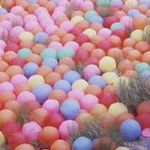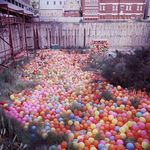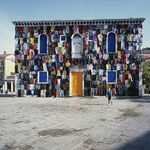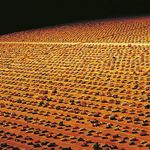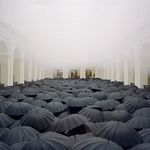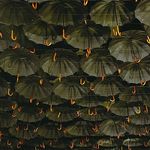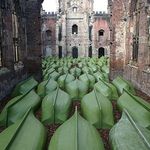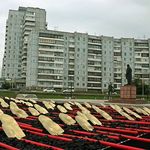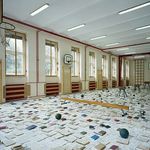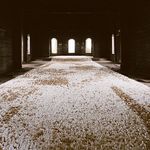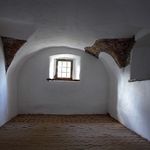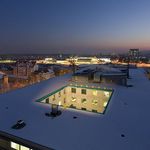Matej Andraž Vogrinčič / I don't know
Matej Andraž Vogrinčič, Ne vem / I don't know
Slavija No 11, Ulica Vita Kraigherja 3, Maribor
opening: Friday, 5 July 2013 at 19:00
Matej Andraž Vogrinčič is the author of site-specific installations in urban and natural landscapes which have addressed the audience throughout the world for more than two decades. His monumental interventions incorporate every-day objects (water cans, balls, shovels, glasses) and transform selected locations into artistically and imaginatively provocative spaces. His installations – found across Europe, Australia, Asia and the USA – have been created in a dialogue with local communities, tradition and history, but with a convincing turn into the unknown.
Ne vem / I don’t know is the first attempt of reviewing Matej Andraž Vogrinčič’s works created in the last 15 years in Ljubljana, Venice, Australia and Siberia. Instead of working on an external venue, the author will this time - rather unusually for him - fill the gallery space with the ‘remains' of his outdoor interventions. In their aestheticised and edited appearance the public space interventions will thus search for their new life in the gallery. I don’t know begins with the work Kovček s srajco / Suitcase with a shirt (1997) which was selected for the milestone U3 Triennial of Slovene Contemporary Art by Peter Weibl. To the author this was a peak of an era when he through experimenting with his own style and with an open enthusiasm for historical avant-garde, especially for Dada ideas, “tailored” clothes for him, for bananas and eventually for a house in Venice during the Venice Biennale (Casa vestita, 1999). After early experiments where multiplication and metamorphosis of common objects were permanent features, the author was given a chance to apply his ideas in totally new dimensions and unexpected settings. His possibly most iconic and monumental works which also attracted extensive media coverage were designed in Australia between 2000 and 2005: 15,000 toy cars for a "blind” facade in Adelaide (Car park – Members Only, 2000), 1800 watering cans in a desert in the heart of Australia (Moon Plain, 2002); 10,000 colourful balls for a deserted construction site in Perth (Beach Balls, 2004) and 1000 umbrellas for the Melbourne old post office (When on a Winter's Night a Traveller, 2005). Next, the exhibition tracks the author’s most prominent intervention in Europe, 56 boats in the ruins of a Gothic church of St. Luke in Liverpool, commissioned for the Liverpool Biennial (Untitled (56 Boats), 2006) and more recent works commissioned for the 7th and 9th Siberian Biennial in Krasnoyarsk (Shovels, 2007; Untitled (Eggs), 2011). I don’t know is concluded by two works in situ which were already exhibited in the course of the European Capital of Culture Maribor 2012: a reconstruction of the ‘Babylon’ tower made of glasses (Impilabile; in co-operation with Ulay, Judgement tower, 2012) and the intervention Bazen /Swimming Pool (after Hockney) which was created on the roof-top of the nearby Hotel Slavija at the end of 2012 for the exhibition 100 years of Slovenian art. By combining the basic swimming elements and bright Californian colours the intervention transformed the bleak light shaft of an office building into a humorous and rather scary illusion of a swimming pool that is both provoking and suggestive. It seems as if Matej Andraž Vogrinčič has - on his way from an dressed suitcase in his hand to the 56 boats in a Gothic church or a swimming pool on a roof top sandy beach – walked the path from a ‘tailor’ to a ‘land-artist’. However, the connection between these temporally and contextually distant works is closer than it seems at first. Despite almost urgent associations to land-artistic approaches, Vogrinčič has never been interested in the late modernistic issue of leaving the white cube and building images in nature. Instead, he has been far more interested in incorporating the absurd, the unestablished and combining ambiguous ideas in the Neo-Dada style. It is no coincidence that his personal art history reference is Ben Vautier, a rather obscure Italian-French avant-garde artist from the 1960’s. In his works one can find the following elements developed further by Vogrinčič: piling of various common objects, witty ideas expressed in simple sentences and anti-establishment. Or – as according to Vautier: no art. If something sublimely beautiful is created as a side product, the author obviously does not mind.
The exhibition’s title I don’t know was a spontaneous reaction to the pressure of having to choose a title; nevertheless, it reveals a constant of Vogrinčič’s work: the vagueness and undefined nature of his art. Vogrinčič’s works are more than anything else questions left unanswered by the author.
Matej Andraž Vogrinčič (Ljubljana, 1970) studied history of art at the Faculty of Arts in Ljubljana. Spatial installations: Pekarna Biennial, 29. Biennial of Graphic Art, Ljubljana (2011); Untitled (Jajca), 9th Biennial of Siberia, Krasnoyarsk, Russia (2011); Stain, Crazy Curators Biennial III, Bratislava (2010); Slovenian pavilion at the World Expo (exterior), Shanghai (2010); Run for Love, Aurillac, France (2009); Pekarna Škuc/Škuc Bakery, Škuc Gallery, Ljubljana (2009); Shovels, 7th Biennial of Siberia, Krasnoyarsk, Russia (2007); Untitled (56 Boats), Liverpool Biennial (2006); When on a Winter's Night a Traveller, Old Post, Melbourne, Australia (2005); Beach Balls, Awesome Festival Perth, Australia (2004); Moon Plain, Coober Pedy, Australia (2002); Car park: Members Only, Adelaide, Australia (2000); Dressed house, Venice (1999); Street Wear, Museum of Modern Art Ljubljana (1997); Dressed house, Ljubljana (1993). Exhibitions: Almost Spring, 100 years of Slovenian Art, Maribor Art Gallery (2012); Les Grands Espaces, Palais des beaux artes, Lille (2010); Muzej na cesti, Museum of Modern Art Ljubljana (2008); Slovenian art 1995-2005, Museum of Modern Art Ljubljana (2005); Slovenian art 1985-1995, Museum of Modern Art Ljubljana (2004); Moon Plain, Museum of Modern Art Ljubljana (2003) and SOFA Gallery, Christchurch, New Zealand (2002); Clothes Sculpture, John Gibson Gallery, New York (1999); Le Coco Fruitware Co., Biennial of Young Artists from Europe and the Mediterranean, Turin (1998); U3, Triennial of Slovene Contemporary Art, Museum of Modern Art Ljubljana (1997); Urbanaria, Soros contemporary art centre, Ljubljana (1995); Ready-made furniture, Škuc Gallery, Ljubljana (1992).
Exhibition curator: Simona Vidmar
Supported by:





